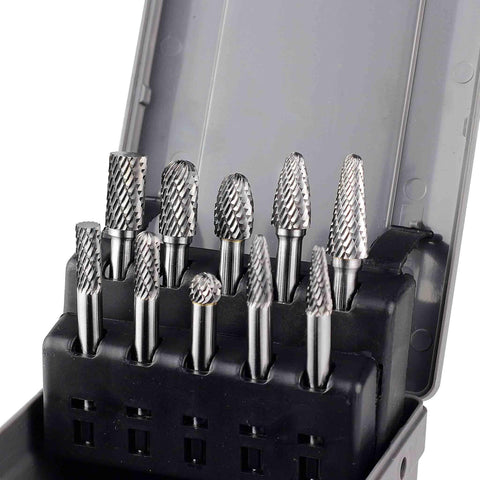Single Cut vs. Double Cut Carbide Burrs: Understanding the Key Differences

Carbide burrs are essential tools in metalworking, woodworking, and other industries requiring precision cutting, shaping, and material removal. They are used in a wide range of applications, from smoothing welds to carving intricate designs. When selecting a carbide burr, one important factor to consider is whether to choose a single cut or double cut burr. Both types have unique advantages, and understanding the differences between them can help you select the right tool for your specific task.
At the core, the distinction between single cut and double cut carbide burrs lies in the way their flutes or cutting edges are arranged. These differences in design affect how the burr cuts, the material removal rate, the type of finish it produces, and the control it offers to the user. Choosing the right type depends on the material being worked on, the desired result, and the level of precision needed.
Single cut carbide burrs have one set of spiral flutes that run in one direction, typically cutting in a right-hand spiral. This design makes single cut burrs highly effective for general-purpose tasks, particularly for material removal on hard surfaces like steel, cast iron, and ferrous metals. The single cutting edge allows the burr to create long, continuous chips as it cuts, which makes it excellent for tasks like milling, deburring, and heavy stock removal. The straightforward design ensures efficient cutting with minimal resistance, and the burr can quickly remove large amounts of material without clogging.
In addition to their efficiency in material removal, single cut carbide burrs also produce a rougher surface finish compared to double cut burrs. This makes them ideal when a smooth finish is not the primary concern, such as in roughing out shapes or prepping a surface for further work. The rougher finish may not be suitable for more delicate or precise tasks, but it can provide a good grip for subsequent processes like welding or bonding.
Single cut burrs also tend to generate less vibration when cutting, which offers more control, especially when working on harder materials. This characteristic can be beneficial in situations where you need to maintain stability during the cutting process. However, the long chips produced by single cut burrs may require more frequent clearing, particularly when working on softer metals like aluminum, which can become clogged in the burr's flutes.
On the other hand, double cut carbide burrs feature two sets of flutes: one running in a right-hand spiral and the other in a left-hand spiral. This dual-flute design creates a cross-cutting action, which offers several distinct advantages. First, the double cut burr produces smaller, finer chips compared to the single cut version. This makes double cut burrs better suited for more precise work where a smoother finish is required. The finer chips also mean that double cut burrs are less prone to clogging, even when used on softer metals like aluminum, copper, or brass.
The cross-cutting action of a double cut burr also provides a smoother, more controlled cutting experience. Because the burr removes material in smaller amounts with each pass, it reduces the amount of force needed to control the tool. This can make it easier to guide the burr and achieve greater accuracy, especially on detailed or intricate workpieces. The smoother finish created by double cut burrs makes them ideal for tasks that require a fine surface, such as finishing edges, refining shapes, or smoothing out welds.
In addition to producing a finer finish, double cut burrs also work well on a wider variety of materials. While single cut burrs excel on hard metals, double cut burrs can handle both hard and soft metals, as well as other materials like plastic or wood. Their versatility makes them a popular choice for jobs where precision and finish quality are important, or where a single tool is needed for multiple types of materials.
Another benefit of the double cut design is that it reduces vibration during use. The cross-cutting action balances the tool's movement, leading to a smoother experience and reducing user fatigue. This makes double cut burrs particularly useful for extended use or for applications that require a steady hand and minimal tool vibration.
However, one potential downside of double cut burrs is that they tend to remove material at a slightly slower rate compared to single cut burrs. Because the cross-cutting action creates finer chips, it's less aggressive in removing large amounts of material quickly. For tasks that require heavy stock removal, a single cut burr might be more efficient. But for precision work or finishing, the smoother, more controlled cut of a double cut burr is often preferable.
In summary, the main differences between single cut and double cut carbide burrs come down to material removal rate, finish quality, and control. Single cut burrs are best for fast, aggressive cutting on hard materials, providing a rough finish suitable for prepping surfaces or removing large amounts of material. Double cut burrs, on the other hand, offer smoother finishes, greater control, and are better suited for precision work and softer materials. By understanding these distinctions, you can choose the right carbide burr for your project, ensuring that you achieve the best results with the least amount of effort.

